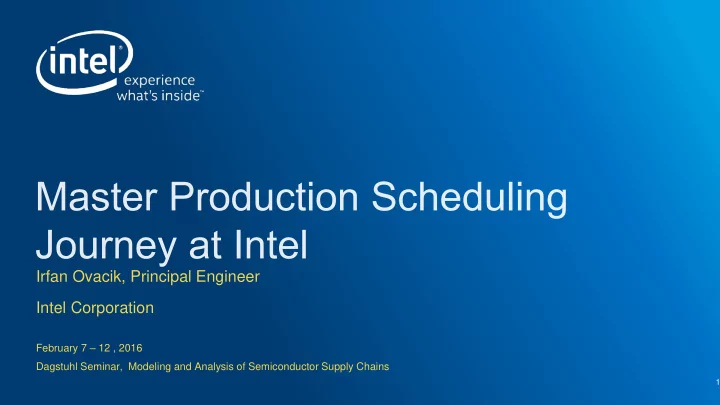

Irfan Ovacik, Principal Engineer Intel Corporation February 7 – 12 , 2016 Dagstuhl Seminar, Modeling and Analysis of Semiconductor Supply Chains 1
Introduction Quick Bio Ph.D. in Industrial Engineering, Purdue University, 1994 i2 Technologies(now JDA Software), 1994-2005 Intel Corporation, 2005-Present Career (and some of childhood) dedicated to planning
Introduction • Supply Chain Decision Solution (SCDS) Group • Part of Customer Fulfillment, Planning and Logistics Group • We build decision support tools that drive the supply chain planning processes within Intel • Common Technical Platform • Well-integrated to Enterprise/Factory Systems • Large Scale Math Modeling/Optimization • Deep bench with wide-range of skills • Software Engineers, Operations Research Engineers • Right mix of expertise in Intel business, industry best practices, and math modeling and optimization techniques 3
Introduction The content builds on previously presented/published material Advanced Planning and Scheduling Systems: The Quest to Leverage ERP for Better Planning, Chapter in Planning in the Extended Enterprise: A State of the Art Handbook; Springer (2011). Emergence and Evolution of Advanced Planning and Scheduling (APS) Systems , Workshop on Planning Production and Inventories in the Extended Enterprise at North Carolina State University (2008) Mostly from a solution provider’s point of view Today’s focus is on Intel’s journey in the last 10 years to build a world class Master Production Scheduling solution
Agenda • Supply Chain Planning Decisions • Master Production Scheduling (MPS) • Definition and Challenges • Industry Approach to MPS • Intel’s Approach to MPS 5
Supply Chain Planning Decisions How do I align capacity to my demand? What do I build at How do I react to each factory? changes in the Strategic factory/demand? Planning Master Production Tactical Scheduling Planning Data Granularity DETAILED AGGREGATE Planning Granularity SHIFT/DAY MONTH/QUARTER Planning Horizon LONG SHORT Planning Frequency LOW HIGH 6
Master Production Scheduling Problem “Optimize” Supply to Meet Demand Across the Entire Manufacturing Network All Stages: Wafer Starts, Assembly/Test Starts, Finish Outs All manufacturing locations – internal/external Considering capacity constraints, material availability, inventory targets and other supply chain constraints by stage Unique Challenges • Trend towards longer Front End (Fab/Sort) and shorter Back End (Assy/Test) lead times • Increased product complexity • Increased supply chain complexity • Evolving customer landscape and expectations • Varying product mixes (high volume/low margin, low volume/high margin) 7
Industry Approach Most large semiconductor companies have chosen their solution providers • All align to an ERP company for the enterprise backbone (SAP/Oracle) • Most use a Best of Breed strategy (primarily JDA) for MPS solutions • Some use offerings from partner ERP companies • These are typically fabless semiconductor companies with a simpler planning problem • Intel is the only exception among the large semiconductor companies • Develop in-house solutions Acknowledgment: Thanks to Puneet Saxena, VP Manufacturing Planning, JDA Software, for information on the latest state of the master production scheduling in semiconductor industry.
Intel’s Approach: Breaking the Problem Down Wafer A/T A/T FG Starts Request Response Response • Fab • Near-Term • A/T Capacity • A/T Capacity Die Feasible Feasible and Die Capacity • Product • Product Feasible Feasible • Product level Family level Family level • Breaks the problem between Front End and Back End (different lead times, different strategies) • Breaks the problem along organizational boundaries • Breaks the problem to manageable subsets which can be optimized efficiently • Provides the opportunity for faster planning cycles • Allows analysis of multiple business scenarios • Supports the decision making process 9
MPS Technical Platform Enterprise Systems Reporting & Analytics MPS Platform Integrated Planning Data Factory Systems Inventory Product BU F/S A/T Inventory Product Health, Product Product Inventory Inventory Product Inventory Health, Capacity Health, Health, Health, Capacity GUI Product Capacity Capacity Planning Product Capacity Product Product Master Data Demand Planning Product Master Data Master Data Master Data Application Algorithms Master Data Build Demand Build Demand Demand Demand Framework Plans Build Build Demand Plans Build Data Plans Planning Strategies Plans Planning Strategies Plans Inventory Planning Planning Strategies Planning Strategies Planning Strategies • Integrated planning data • Explain plans • Common Planning • Compare scenarios • Ensures all planning data Application Framework • Compare historical plans • Designed and developed is complete, current and • Provide visibility into key in-sync in-house with strong • Provides mechanisms for business metrics partnership with business • Identify opportunities • Optimized for Intel’s SC proactive, automated data quality needs 10
Lessons Learned • Understand the business needs • Go at a speed the business can absorb • Pay attention to ALL components of the planning solution • Data infrastructure, data availability/quality • User interfaces/reports, analysis/explain-ability of results • Mathematical modeling and optimization alone do not solve the problem
Recommend
More recommend